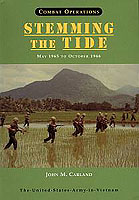U.S. Army in Vietnam

STEMMING THE TIDE, MAY 1965 TO OCTOBER 1966 COMBAT OPERATIONS
John M. Carland
U.S. Army in Vietnam
CMH Pub 91-5, Cloth; CMH Pub 91-5-1, Paper
2000; 410 pages, illustrations, maps, tables, bibliographical note, index
GPO S/N: 008-029-00354-6, Cloth; GPO S/N: 008-029-00355-4, Paper
Combat Operations: Stemming the Tide describes a critical chapter in the Vietnam conflict, the first eighteen months of combat by the U.S. Army's ground forces. Relying on official American and enemy primary sources, John M. Carland focuses on initial deployments and early combat and takes care to present a well-balanced picture by discussing not only the successes but also the difficulties endemic to the entire effort. This fine work presents the war in all of its detail: the enemy's strategy and tactics, General William C. Westmoreland's search and destroy operations, the helicopters and airmobile warfare, the immense firepower American forces could call upon to counter Communist control of the battlefield, the out-of-country enemy sanctuaries, and the allied efforts to win the allegiance of the South Vietnamese people to the nation's anti-Communist government. Carland's volume demonstrates that U.S. forces succeeded in achieving their initial goals, but unexpected manpower shortages made Westmoreland realize that the transition from stemming the tide to taking the offensive would take longer. Bruising battles with the Viet Cong and North Vietnamese in the Saigon area and in the Central Highlands had halted their drive to conquest in 1965 and, with major base development activities afoot, a series of high-tempo spoiling operations in 1966 kept them off balance until more U.S. fighting units arrived in the fall. Carland credits the improvements in communications and intelligence, the helicopter's capacity to extend the battlefield, and the availability of enormous firepower as the potent ingredients in Westmoreland's optimism for victory, yet realizes that the ultimate issue of how effective the U.S. Army would be and what it would accomplish during the next phase was very much a question mark.
* View this publication online.